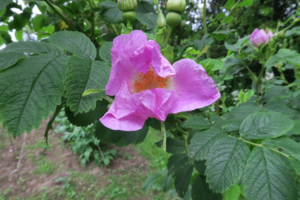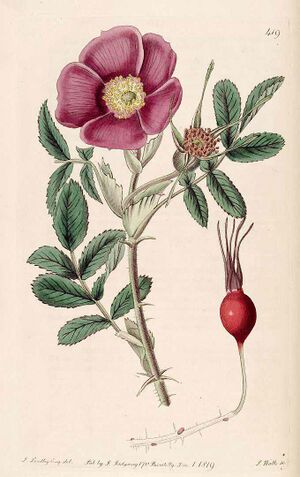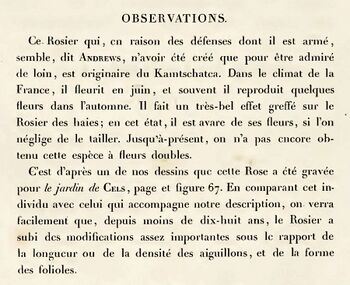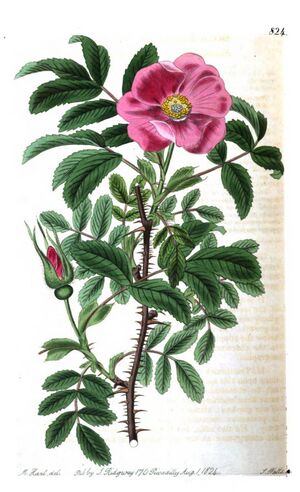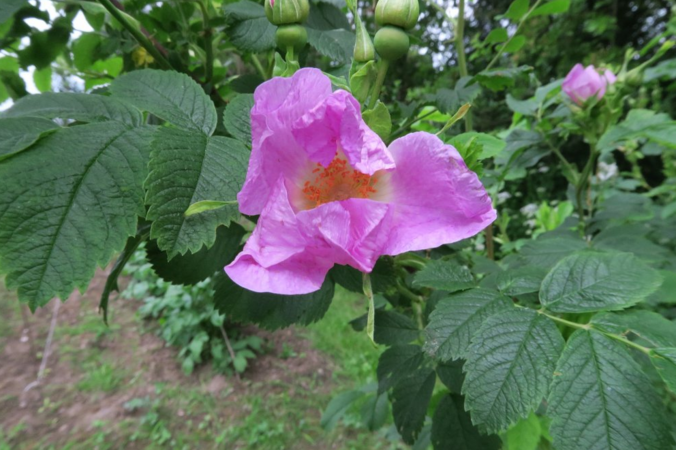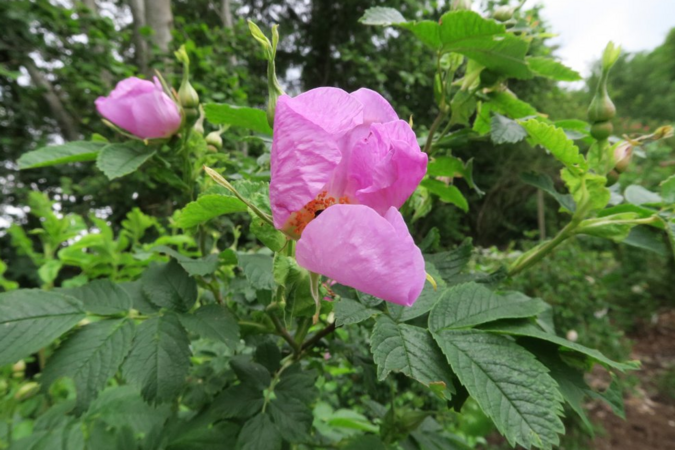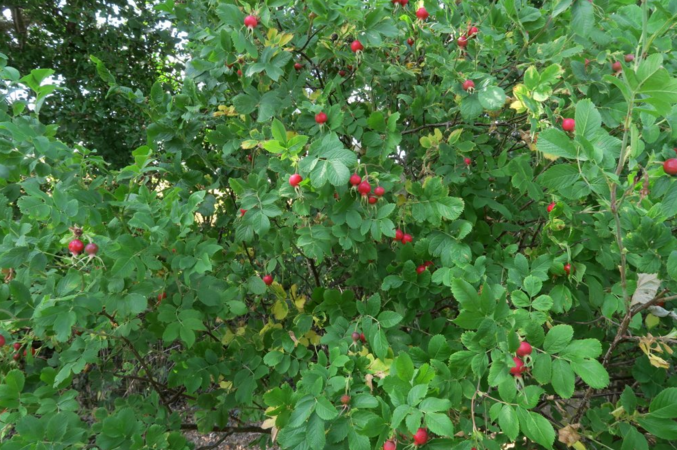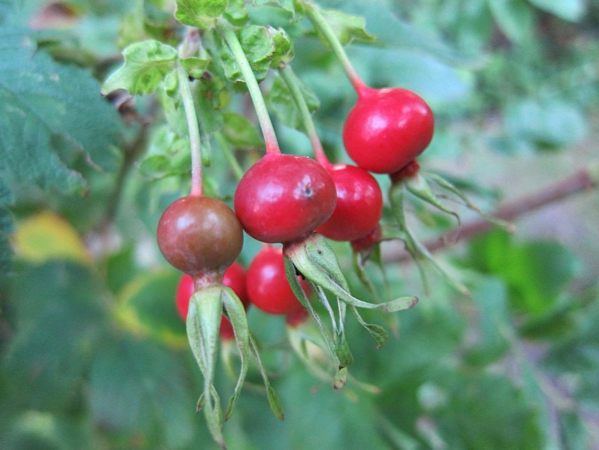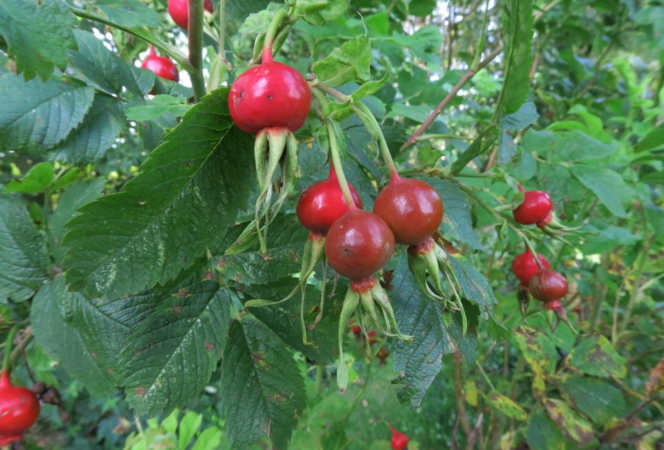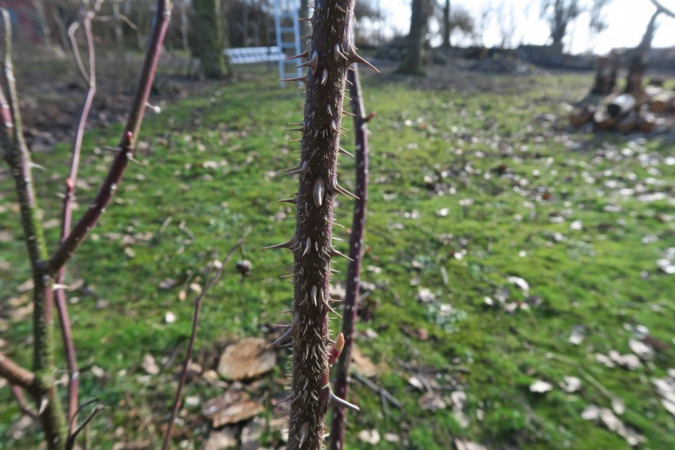Kamtchatica
Botanische-Kreuzung, um 1770 in Kamtschatka, Ostrussland entstanden oder gefunden. 1802 von Jacques-Martin Cels nach Europa gebracht und vom Botaniker Étienne Pierre Ventenat, Frankreich, beschrieben.
Botanische-Kreuzung, +/- 1770 in Kamtschatka, East Russia (found or obtained). Brought to Europe by Jacques-Martin Cels and described by the botanist Étienne Pierre Ventenat, France in 1802.
Botanische-Kreuzung, trouvée ou obtenue en 1770 au Kamtschatka, en Russie de l'Est. Amenée en 1802 en Europe par Jacques-Martin Cels et décrite par le botaniste Étienne Pierre Ventenat, France.
Eltern/parentage/parents: Rosa davurica Pall. x Rosa rugosa Thunb..
Synonyme/synonyms/synonymes: Rosa x kamtchatica Vent., Rosa kamtchatica Vent., Rosa rugosa Thunb. var. kamtchatica (Vent) Regel, 'Kamchatka Rose', 'Rosier du Kamtschatka'.
Allgemeines • Preface • Remarques
Diese Naturhybride wurde um 1800, als sie nach Europa kam, als Art beschrieben. Erst später stellte man fest, dass es sich um eine Hybride handelt, wobei auch Rosa amblyotis C.A.Mey. x Rosa rugosa Thunb. als Eltern genannt werden, da Rosa amblyotis eng mit Rosa davurica verwandt ist.
Es existierte eine weiße Varietät Rosa x kamtchatica 'Alba Simplex', die die Cochets als Pollenspender für einige Kreuzungen verwendeten.
This natural hybrid was described as a separate type when it arrived around 1800 in Europe. Later on it was discovered that the rose is a hybrid, whose parents were Rosa amblyotis C.A.Mey. x Rosa rugosa Thunb., as Rosa amblyotis is closely related to Rosa davurica.
A white variant exists Rosa x kamtchatica 'Alba Simplex', whose pollen was used by Cochets for hybdidisation purposes.
Cet hybride naturel, introduit en Europe aux alentours de 1800 fut décrit comme un type de rosier à part. C'est seulement plus tard qu'on se rendit compte qu'il s'agissait en fait d'un hybride, avec comme parents Rosa amblyotis C.A.Mey. x Rosa rugosa Thunb., étant donné que Rosa amblyotis est proche parente de Rosa davurica.
Un variant blanc existe Rosa x kamtchatica 'Alba Simplex', dont le pollen fut utilisé par Cochets à des fins d'hybridisations.
Übersetzung:
Anmerkung:
Die Farbe entspricht nicht der der zwei anderen Tafeln. Dennoch in der vorangehenden Blütenbeschreibung, wird sie als "nacarat tirant sur le violet" = "violettlich nacarat" angegeben; "nacarat" ist zwar ein sehr vager Begriff, dennoch "violettlich" deutet auf eine Farbe hin, wie man sie auf den anderen Tafeln beobachten kann. In dem Buch von E.-P. Ventenat "Description des plantes nouvelles et peu connues, cultivées dans le jardin de J.-M. Cels", für das die Tafel bestimmt war, kann man ohnehin lesen, die Rose sei dunkelrosa.
Translation:
Remark:
The colour does not correspond to the one of the two illustrations. Despite of this, the previous descriptions talk about a nacred violet (nacred being a very vague notion); the violet corresponding however to the colour description in other illustrations. In the book of E.-P. Ventenat "Description des plantes nouvelles et peu connues, cultivées dans le jardin de J.-M. Cels", (description of new, little known plants cultivated in J.-M. Cels's garden) -corresponding to the illustration - the rose was described as dark pink.
Blüten • Blooms • Fleurs
Mittelgroße (5 cm Ø), ungefüllte, schalenförmige Blüten mit gelb-rötlichen Staubgefäßen. Rundlich-spitze Knospen mit sehr lang überstehenden, blättrigen Kelchnlättern. Öfterblühend.
Medium-sized (5 cm Ø), unfilled, bowl-shaped flowers with yellow-reddisk stamens. Spherical/pointed buds with long suprassing "leafy" sepals. Repeat flowering.
Fleurs de taille moyenne (5 cm Ø), non remplies, en forme de bols, aux étamines jaune-rougeâtres. Boutons floraux sphériques/pointus avec de longues sépales les dépassant. Floraison répétée.
Farbe • Color • Coloris
Lila überhauchtes Rosa, weißer Blütengrund.
Violet-pink on a white petal base.
Rose avec une touche violacée sur base blanche de pétales.
Hagebutten • Hips • Fruits
Mittelgroße (15 mm Ø), rote Hagebutten mit anhaftenden Kelchblättern.
Medium-sized (15 mm Ø), red hips with attached sepals.
Cynorrhodons rouges de taille moyenne (15 mm Ø) aux sépales y attachés.
Wuchs • Growth • Port
Großer Strauch, 2,0 m.
Tall shrub, 2,0 m.
Arbuste pouvant atteindre 2,0 m.
Blätter • Foliage • Feuillage
7- bis 9-fiedriges, dunkelgrünes Laub mit ovalen, grob gezähnten genarbten und tief geäderten Blättern, meist ohne Spitze.
Dark-green foliage with 7-9 feathery oval/deeply veined, scarred and roughly indented leaflets (often without tips).
Feuillage vert-foncé, avec 7-9 folioles en forme de plumes, ovales/rugueuses/aux veines profondes, grossièrement dentées; souvent non-pointues.
Triebe und Bestachelung • Sprouts and spines • Branchage et aiguillons
Aufrechte Triebe mit zahlreichen kleinen, schlanken Stacheln und großen, schlanken, etwas verbreiterten Stacheln in Abständen von 2 - 3 cm.
Straight, upright growing sprouts with numerous, small/thin spines as well as large/thin/slightly enlarged spines distanced by 2 - 3 cm.
Tiges verticales, aux nombreuses épines petites/fines ainsi que de larges aiguillons/minces, légèrement élargis et distants de 2 - 3 cm.
Meine Rose • My rose • Mon rosier
Galten
Bitte beachten Sie, dass der Duft mit der Tageszeit, der Temperatur und Luftfeuchte stark schwanken kann!
Eine Rose kann morgens Duftklasse 4 sein und nachmittags nur noch 1!
Please bear in mind, that the fragrance may intensely vary during the day, or by temperature or humidity.
In the morning it may be category 4, in the afternoon only 1!
Il faut savoir que le parfum d'une rose peut fortement varier selon le moment de la journée, la température et l'humidité de l'air.
Le parfum d'une rose peut appartenir, le matin, à la catégorie 4, et l'après-midi, à la catégorie 1!
| Duftkategorien | Categories of fragrance | Catégories de parfums | |
|---|---|---|---|
| 0 | kein Duft | no fragrance | aucun parfum |
| 1 | schwacher Duft | very mild fragrance | parfum léger |
| 2 | mittlerer Duft | mild fragrance | parfum modéré |
| 3 | starker Duft | strong fragrance | parfum fort |
| 4 | verströmt starken Duft | diffuses a strong fragrance | parfum à large dispersion |
Die Rose wächst veredelt in Galten bei Aarhus, Jytland, Dänemark in Lenas und Erlings Rugosa-Garten.
The grafted rose plant grows in Galten near Aarhus, Jytland, Dänemark in Lenas and Erlings Rugosa-Garten.
Le rosier greffé pousse à Galten près d'Aarhus, Jytland, Dänemark dans Lenas et Erlings Rugosa-Garten.
Der Duft ist schwach.
Weak scent.
Peu parfumé.
Meine Rose duftet folgt.
- Kamtchatica
Fotos Erling Østergaard
↑ Nach oben • Top • Vers le haut ↑
Einzelnachweis • Footnotes • Note
Weblinks • External links • Liens externes
Literatur • Literature • Littérature
- Les Roses I, P. J. Redouté, C. A. Thory, 1817, Text und Abbildung
- E.-P. Ventenat, Description des plantes nouvelles et peu connues, cultivées dans le jardin de J.-M. Cels, Bild und Text
- The Botanical Register, Consisting of Coloured Figures of Exotic Plants, cultivated in British Gardens, Vol. 10, Bild und Text
